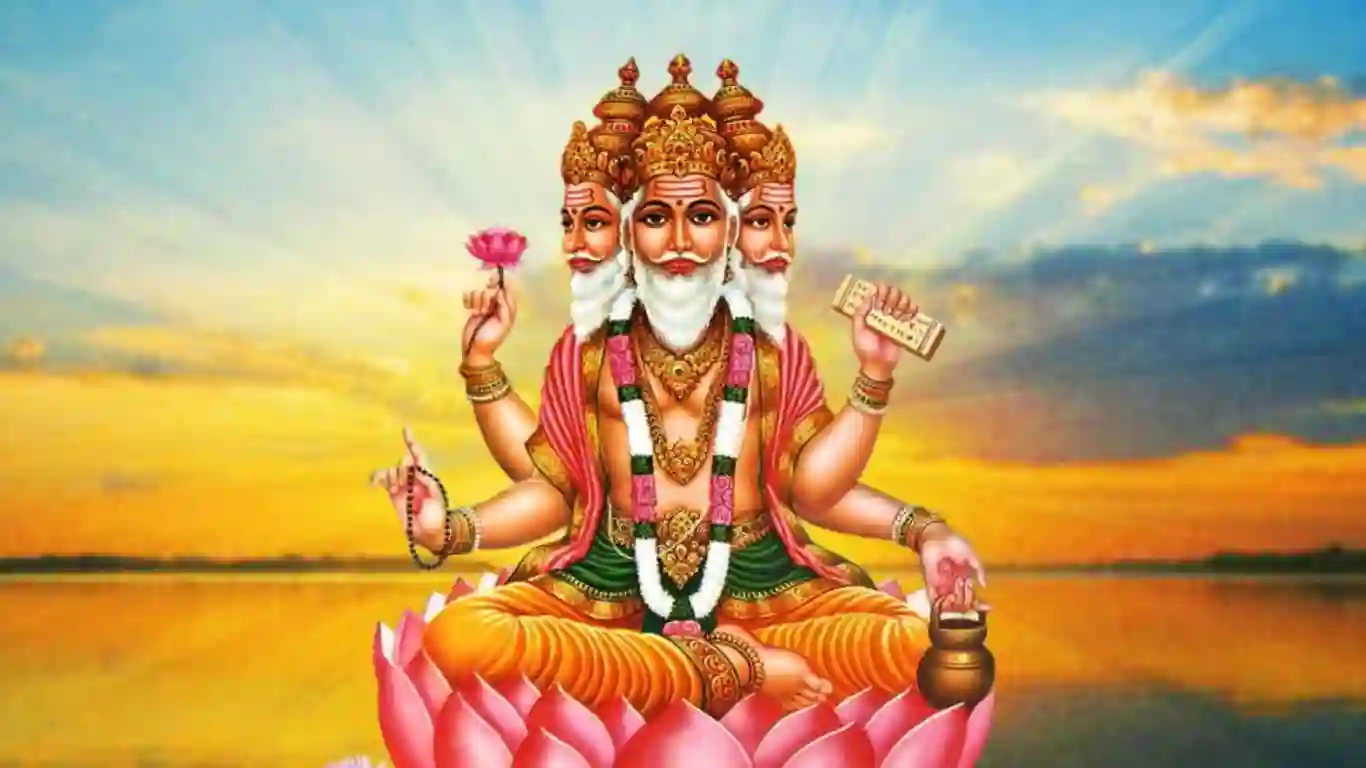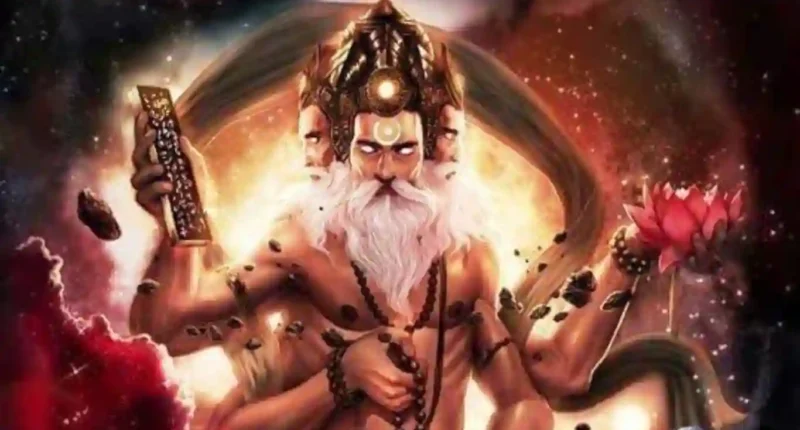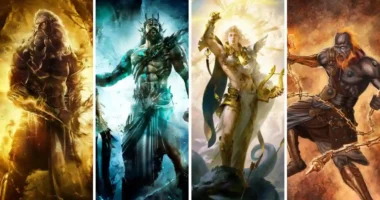Lord Brahma is a Hindu God associated with the concepts of creation and knowledge. Within the Trimurti – which is the triad of the supreme Gods in Hindu mythology – Brahma holds the title of the Creator. The Trimurti also includes the God Shiva and God Vishnu, who are referred to as the Destroyer and the Protector, respectively. In this article, we will be looking specifically at the creation deity – Brahma.
Brahma, whenever mentioned in the Vedas (religious texts written in Sanskrit and the scripture of the Hindu religion), is a part of creation myths and legends. Some Puranas also record Brahma creating himself inside a golden embryo called ‘Hiranyagarbha’, through which the universe was also created. Brahma has had many names in the scriptures like Svayambhu, Virinchi and most frequently Prajapati in the Vedas.

In the beginning, Brahma held significant prominence as far as Hindu deities were concerned. However, with the passing of time, Brahma’s importance began declining, especially as the significance of other deities such as Shiva and Vishnu grew considerably. Comparatively to the other two divine deities in the Trimurti, Brahma’s worship is considered secondary. Temples and places of worship dedicated solely to this god are usually rare as well. In depictions, Brahma is often depicted with four heads, each of which is symbolic of a particular Veda and faces the four cardinal directions. Usually, he can also be seen seated on a large lotus. As the Creator and god of Creations, it is believed that Brahma created his own children from his mind, which is why they are known as Manasputra.
In Vedic Philosophy and some literature, the term ‘Brahman’ refers to the concept of an ‘Ultimate Reality’, which, in simple terms signifies the highest form of existence, the final cause for everything’s existence. Though there is no certain proof, it has been the belief of some scholars that Brahma as a spiritual deity came into existence as a personification of this concept of the Vedic Brahma. In the Vedas, the earliest mention of this deity, Brahma was in the ‘Maitrayaniya Upanishad’ in a hymn known as Kutsayana Hymn. The hymn ‘Kutsayana Hymn’ asserts the fact that the soul within a person is, in fact, a manifestation of the Lord Brahma.
Beyond the Vedic period, Brahma was still one of the most important deities with a sect following him, There is a Purana by the name of ‘Brahmananda Purana’, which as the name suggests focuses on the deity Brahma and his conception. According to this Purana, Brahma emerged from a golden egg, known as the Hiranyagarbha, within which he had created himself. The Hiranyagarbha is also mentioned in the Rigveda once. Brahma, as the creator, then was responsible for the creation of the earth, the people and ultimately the entire universe.

With time, however, Brahma’s significance, as compared to the rest of the deities, would become lesser and lesser. The reasons for his downfalls are mentioned in some of the Puranic legends. In the Shiva Purana, the reason for Brahma’s decline is cited as the time when once Brahma and Vishnu were in the middle of an argument concerning who between the two was the greatest when they heard a disembodied voice ask them to find the end of a lightning pillar that had appeared before them. The voice also proclaimed that whoever will find the end of the pillar first would be given the title of the greatest. Vishnu went looking for the bottom end of the pillar while Brahma went to the top.
After searching diligently, they both returned. Vishnu accepted defeat with complete honesty and confessed that he could not find the end, Brahma, on the other hand, lied and said that he had found the top end of the pillar. Once they had both said their piece, the voice revealed itself to be Shiva and the pillar to be the Shiva Linga. Angered by Brahma’s lies, Shiva put a curse on him saying he would never be worshipped again. This story is only one of the many reasons which are found to be responsible for Brahma’s downfall.
According to the Vedic philosophy, the world and the universe are always in a state of change. In most, if not all, Vedic texts Brahma is considered the primary creator, who is the one responsible for the creation of the world. There are some texts that would refer to Brahma as the ‘secondary creator’ rather than the first, albeit some texts would consider another god or goddess as the secondary creator altogether. Unlike the Vedic texts, the Mahabharata and the Puranas would consider Brahma as only the ‘secondary creator’.
One story would say that Brahma was born from the lotus which emerged from the god Vishnu’s navel. While another story from a Purana focused on Shiva would go on to say that both Brahma and Vishnu were created by the Ardhanarishvara – half Shiva and half Parvati. The stories revolving around Brahma’s existence are many and varied and it is difficult to know which one of these is the most accurate. However, something that can be determined by the Puranic texts, at least, is that Brahma was the one who created the forms of the universe, though not the entire universe itself.

Brahma’s depictions in paintings and idols is often shown with four faces and four arms. The arms hold out artefacts that signify creation and knowledge, rather than means of destruction like weapons. Brahma also can be seen holding the Vedas, the sacred scripture. The four faces always face a separate cardinal direction and are supposedly responsible for the creation of the Vedas, itself. Brahma is given a very wise appearance in his depictions to signify his virtues and is often shown as sitting on a lotus with a swan (hansa), his vehicle on his side.
As far as worship of the deity Brahma is concerned, there are only a handful of temples dedicated solely to Brahma. One of the most prominent Hindu temples made for Brahma resides in Puskar, a place in the state of Rajasthan, known as the Jagatpita Brahma Mandir situated near the Pushkar Lake, which is also considered sacred. There are certain temple complexes which dedicate themselves to the Trimurti, where along with Shiva and Vishnu, Brahma was also worshipped. Some of these include Thanumalayan Temple and Thripaya Trimurti Temple. There are a few more temples dedicated to the God Brahma in the south of India.
Brahma as a deity is worshipped not only in the country of India but also in other countries on the Asian continent. For instance, in Angkor Wat, the temple complex in Cambodia, a shrine for Brahma can be found. There is also a statue of the deity at the Erawan Shrine of Bangkok, Thailand. Indonesia’s Hindu population hold the god Brahma in very high regard, and a temple dedicated only to him, named Andakasa Temple can be found in Bali.
Also Read: 3 Hindu gods also known as Trimurti | Brahma (creator) | Vishnu (preserver) | Mahesh (destroyer) | Explained



